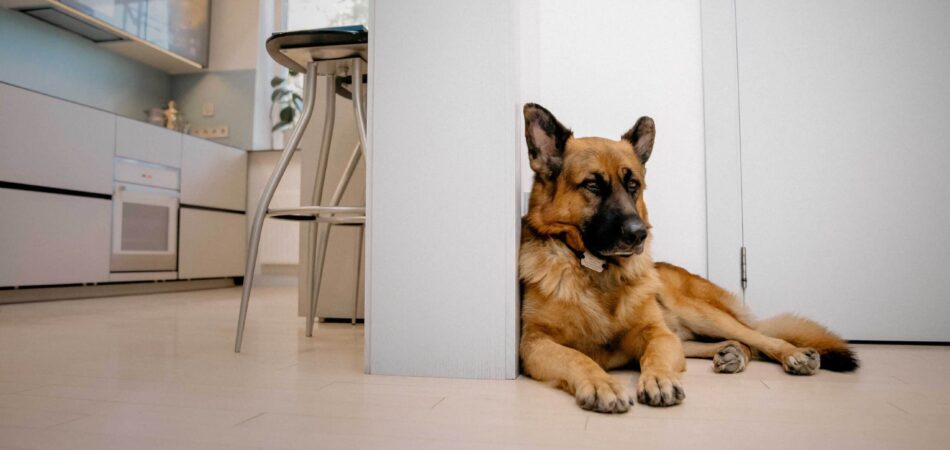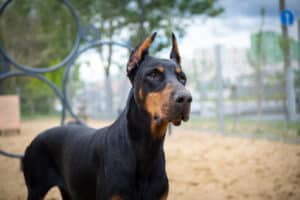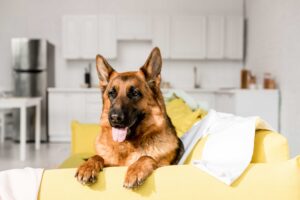






We crave security and companionship. It’s in our DNA, an ancient instinct buried beneath the noise of city life. Maybe that’s why nearly three-quarters of renters share their homes with pets.
For centuries, humans have relied on dogs as protectors. But modern apartment living presents a dilemma: landlords love the idea of “pet-friendly” policies until you ask about breed restrictions and weight limits.
Suddenly, your options shrink. Although 78% of apartment buildings claim to welcome pets, many exclude the breeds best suited for protection.
So, does this mean apartment dwellers have to choose between safety and a protection dog? Absolutely not.
Contrary to common belief, numerous breeds make excellent protection dogs for apartments. They don’t need a sprawling backyard. They don’t need endless space. What they need is the right home—and the right purpose.
So, if you want a dog that fits into the realities of apartment living while keeping you safe, you’re in the right place. This isn’t about what’s “expected.” It’s about what works.
Some breeds excel in close quarters while still providing elite protection.
Here’s a look at the best:
Average Height: 26-28 inches (male), 24-26 inches (female)
Average Weight: 75-100 pounds (male), 60-90 pounds (female)
Life Expectancy: 10-13 years
Doberman Pinschers are among the best protection dogs for apartment living, combining intelligence, agility, and loyalty.
Their lean, muscular frame allows them to navigate smaller spaces with ease, and their sharp instincts make them highly responsive to training.
Recognized for their sleek, athletic build, wedge-shaped head, and alert, upright ears, Dobermans possess a short, low-maintenance coat that comes in black and rust, red, blue, or fawn, with distinct rust markings on their face, chest, and legs.
Beyond their formidable presence, Dobermans are deeply devoted companions, highly attuned to their owners’ emotions.
However, their working-dog heritage means they thrive on structure, mental engagement, and consistent training to prevent restlessness.
Why They Work:
 Sleek, medium-large build fits well in apartment spaces
Sleek, medium-large build fits well in apartment spacesChallenges:
Average Height: 24-27 inches (male), 22-25 inches (female)
Average Weight: 95-135 pounds (male), 80-100 pounds (female)
Life Expectancy: 8-11 years
Powerful, confident, and deeply loyal, the Rottweiler is a natural guardian. Despite their imposing presence, these dogs are surprisingly adaptable to apartment living—provided they receive proper training and exercise.
Their calm demeanor indoors contrasts with their protectiveness, making them excellent companions for those seeking both security and companionship.
Physically, Rottweilers are distinguished by their broad chest, muscular build, and large, blocky head. Their short, dense coat is typically black with rich rust markings on their face, chest, and legs. Their deep-set, intelligent eyes convey both warmth and quiet vigilance.
Beneath their formidable exterior lies a deeply affectionate and family-oriented dog. Rottweilers form strong bonds with their owners and are known for their steady temperament.
However, their protective instincts require early socialization and consistent leadership to ensure they remain well-mannered and discerning.
Why They Work:
Challenges:
Average Height: 24-26 inches (male), 22-24 inches (female)
Average Weight: 65-95 pounds (male), 50-70 pounds (female)
Life Expectancy: 9-13 years
German Shepherds are the gold standard for protection dogs. Intelligent, fearless, and deeply loyal, they have served as working dogs in police and military units worldwide.
But beyond their tactical skills, they are also affectionate family companions—protective without unnecessary aggression.
With their strong, athletic build and signature black-and-tan coat, German Shepherds are instantly recognizable. Some may also be solid black or sable. Their thick double coat protects them from harsh weather but requires regular grooming to manage shedding.
Highly trainable and eager to please, German Shepherds thrive when given structure and purpose. However, their intelligence and work ethic mean they require daily mental and physical stimulation.
Why They Work:
 Highly intelligent and trainable
Highly intelligent and trainableChallenges:
Average Height: 24-26 inches (male), 22-24 inches (female)
Average Weight: 60-80 pounds (male), 40-60 pounds (female)
Life Expectancy: 12-14 years
Frequently employed by military and law enforcement, these dogs possess an unmatched work ethic and thrive when given a purpose.
While their high energy makes them best suited for experienced owners, with proper training, they can adapt to apartment living.
The Belgian Malinois has a lean, athletic build, with a slightly longer body than its height. Their short, fawn-colored coat is typically accompanied by a black mask and ears, giving them a striking appearance.
Their coat is low-maintenance, and while they do shed, it’s far less than many other protection breeds.
Beyond their physical capabilities, Belgian Malinois form deep, intense bonds with their owners. They are incredibly loyal and protective but require structured training, daily exercise, and mental challenges to prevent boredom and destructive behaviors.
Why They Work:
Challenges:
Average Height: 25-27 inches (male), 24-26 inches (female)
Average Weight: 100-130 pounds (male), 90-120 pounds (female)
Life Expectancy: 8-10 years
A surprising addition? Maybe. But Bullmastiffs make excellent apartment protection dogs. Originally bred to guard large estates, these gentle giants are known for their calm demeanor.
They don’t need constant activity to stay happy—just a loving home and a purpose.
With a massive, muscular build and a broad, wrinkled face, Bullmastiffs have an imposing presence. Their short, dense coat comes in fawn, red, or brindle, requiring minimal grooming.
Despite their size, they are surprisingly low-energy indoors, making them well-suited for apartment living—so long as they receive regular exercise.
Bullmastiffs are natural guardians with a keen sense of intuition. They are affectionate with their families but reserved around strangers, making them good deterrents.
However, due to their independent nature, they require firm, consistent training from an early age to reinforce obedience and socialization.
Why They Work:
Challenges:
Let’s start with rental laws and breed restrictions. Many landlords and apartment complexes have policies that prohibit certain breeds, especially larger or naturally protective ones. Always check regulations before making a decision.
Noise is another key factor. Protection dogs are naturally alert, and some breeds are more vocal than others.
If your building has thin walls or you live close to other people and dogs, a breed prone to excessive barking may not be the best fit.
Space matters, but not as much as energy levels. Many assume that a large dog needs a large home, but in reality, an active owner who provides plenty of physical and mental stimulation can meet a high-energy dog’s needs even in a small apartment.
If you regularly take your dog out to train, run, and explore, an energetic breed can still thrive. On the flip side, a person with a big apartment but a sedentary lifestyle may struggle to manage a high-drive protection dog.
Socialization is another crucial consideration. Living in an apartment means frequent encounters with neighbors, other pets, and children. A well-socialized protection dog understands the difference between a legitimate threat and everyday interactions.
Training and exposure to different environments will help ensure your dog remains confident and well-adjusted rather than reactive or overly aggressive.
Finally, consider adaptability. Elevators, stairwells, and narrow hallways can present challenges for larger breeds.
Ensuring your dog is well-trained in these urban settings is essential, as adaptability will contribute significantly to their comfort and confidence in your apartment environment.
🚨 Don’t wait until it’s too late. Let’s find your ideal protection companion today here at Vanguard Protection Dogs.